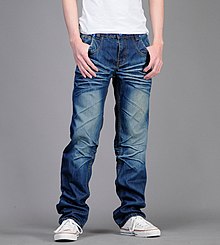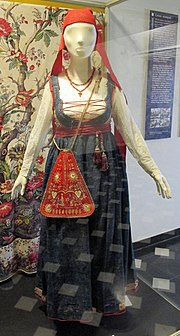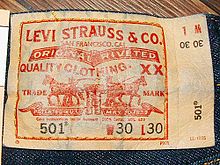Jeans

Jeans are trousers typically made from denim or dungaree cloth. Often the term "jeans" refers to a particular style of pants, called "blue jeans," which were invented by Jacob Davis in 1871[1] and patented by Davis and Levi Strauss on May 20, 1873. Originally designed for cowboys and miners, jeans became popular in the 1950s among teenagers, especially members of the greaser subculture. Jeans were a common fashion item in the 1960s Hippie subculture and they continued to be popular in the 1970s and 1980s youth subcultures of punk rock and heavy metal. Historic brands include Levi's, Lee, and Wrangler. In the 2010s, jeans remain a popular fashion item, and they come in various fits, including skinny, tapered, slim, straight, boot cut, cigarette bottom, narrow bottom, low waist, anti-fit, and flare. "Distressed" (visibly aged and worn, but still intact and functional) jean trousers have become increasingly fashionable, making pre-sale "factory distressing" a common feature in commercially sold jeans.
Jeans are now a very popular article of casual dress around the world. They come in many styles and colors. However, blue jeans are particularly identified with American culture, especially the Old West. As well, although jeans are mostly known as a fashion garment in the 2010s, they are still worn as protective garments by some individuals, such as cattle ranch workers and motorcycle riders, due to their high durability as compared to other common fabrics.
History

Jean fabric
Research on the trade of jean fabric shows that it emerged in the cities of Genoa, Italy, and Nimes, France. Gênes, the French word for Genoa, may be the origin of the word "jeans". In Nimes, weavers tried to reproduce jean but instead developed a similar twill fabric that became known as denim, from de Nimes, meaning "from Nimes". Genoa’s jean was a fustian textile of “medium quality and of reasonable cost”, very similar to cotton corduroy for which Genoa was famous, and was "used for work clothes in general". Nimes’s “denim” was coarser, considered higher quality and was used "for over garments such as smocks or overalls".[2] Nearly all Indigo, needed for dying, came from indigo bush plantations in India till the late 19th century. It was replaced by indigo synthesis methods developed in Germany.[3]

By the 17th century, jean was a crucial textile for working-class people in Northern Italy. This is seen in a series of genre paintings from around the 17th century attributed to an artist now named The Master of the Blue Jeans.[4] The ten paintings depict impoverished scenes with lower-class figures wearing a fabric that looks like denim. The fabric would have been Genoese jean, which was cheaper. Genre painting came to prominence in late 16th century, and the low-life subject matter in all ten paintings places them among others that portray similar scenes.[5]
Denim is not the only sturdy cotton fabric used for everything from working clothes to fashion items. There is also dungaree. Dungaree was mentioned for the first time in the 17th century, when it was referred to as cheap, coarse thick cotton cloth, often colored blue but sometimes white, worn by impoverished people in what was then a region of Bombay, India a dockside village called Dongri. This cloth was "dungri" in Hindi. Dungri was exported to England and used for manufacturing of cheap, robust working clothes. English began to call "dungri" cloth a little different and it became "dungaree".[6]
The importance of jean is also shown by the history of textile trade. Genoese sailors used jean to cover and protect their goods on the docks from the weather. During the Republic of Genoa (17th, 18th centuries), sailors exported jeans throughout Europe.
The invention of the zipper, by Whitcomb L. Judson, helped as well.
Jean became popular in the United States when Levi Strauss & Co.'s introduced blue jean overalls in 1873.[7]
Riveted jeans
Levi Strauss, as a young man in 1851, went from Germany to New York to join his older brothers who ran a goods store. In 1853, he moved to San Francisco to open his own dry goods business. Jacob Davis was a tailor who often bought bolts of cloth from the Levi Strauss & Co. wholesale house. In 1872, Davis wrote to Strauss asking to partner with him to patent and sell clothing reinforced with rivet.[8] The copper rivets were to reinforce the points of stress, such as pocket corners and at the bottom of the button fly. Levi accepted Davis's offer,[9] and the two men received US patent No. 139,121 for an "Improvement in Fastening Pocket-Openings" on May 20,1873.[10]

Davis and Strauss experimented with different fabrics. An early attempt was brown cotton duck, a bottom-weight fabric. Finding denim a more suitable material for work-pants, they began using it to manufacture their riveted pants. The denim used was produced by an American manufacturer, but popular legend states it was imported from Nimes, France. A popular myth is that Strauss initially sold brown canvas pants to miners, later dyed them blue, turned to using denim, and only after Davis wrote to him, added rivets.[8]
Worldwide market for jeans
North America accounts for 39% of global purchases for jeans, followed by Western Europe at 20%, Japan and Korea at 10% and the rest of the world at 31%.[11]
United States citizens spent more than US$14 billion on jeans in 2004 and US$15 billion in 2005.[12] US people bought US$13.8 billion of men's and women's jeans in the year which ended 30 April 2011, according to market-research firm NPD Group.[13]
Evolution of the garment
The term appears first in 1795, when a Swiss banker by the name Jean-Gabriel Eynard and his brother Jacques went to Genoa and both were soon heading a flourishing commercial concern. In 1800 Massena's troops entered the town and Jean-Gabriel was entrusted with their supply. In particular he furnished them with uniforms cut from blue cloth called "bleu de Genes" whence later derives the famous garment known worldwide as "blue jeans".
Initially, jeans were simply sturdy trousers worn by factory workers[citation needed]. During this period, men's jeans had the zipper down the front, whereas women's jeans had the zipper down the left side. Fewer jeans were made during World War II, but 'waist overalls' were introduced to the world by US soldiers, who sometimes wore them off duty[citation needed]. By the 1960s, both men's and women's jeans had the zipper down the front. Historic photographs indicate that in the decades before they became a staple of fashion, jeans generally fit quite loosely, much like a pair of bib overalls without the bib. Indeed, until 1960, Levi Strauss called its flagship product "waist overalls" rather than "jeans".

After James Dean popularized them in the movie Rebel Without a Cause, wearing jeans became a symbol of youth rebellion during the 1950s. Because of this, they were sometimes banned in theaters, restaurants and schools.[citation needed]During the 1960s the wearing of jeans became more acceptable, and by the 1970s it had become general fashion in the United States for casual wear.[14]
Michael Belluomo, editor of Sportswear International Magazine, Oct/Nov 1987, P. 45, wrote that in 1965, Limbo, a boutique in the New York East Village, was "the first retailer to wash a new pair of jeans to get a used, worn effect, and the idea became a hit." He continued, "[Limbo] hired East Village artists to embellish the jeans with patches, decals, and other touches, and sold them for $200." In the early 1980s the denim industry introduced the stone-washing technique developed by GWG also known as "Great Western Garment Co." Donald Freeland of Edmonton, Alberta pioneered the method,[15] which helped to bring denim to a larger and more versatile market. Acceptance of jeans continued through the 1980s and 1990s to the point where jeans are, in the first decade of 21st century, a wardrobe staple, with the average North American owning seven pairs.[16][verification needed] Currently, jeans may be seen worn by people of all genders and ages.
Manufacturing processes
Dyeing

Traditionally, jeans were dyed to a blue color using natural indigo dye. Most denim is now dyed using synthetic indigo. Approximately 20 thousand tons of indigo are produced annually for this purpose, though only a few grams of the dye are required for each pair.[17] For other colors of denim other dyes must be used. Currently, jeans are produced in any color that can be achieved with cotton.
For more information on dyeing, refer to denim and the discussion there of using pigment dyes.
Pre-shrinking

In 1962 Levi Strauss introduced pre-shrunk jeans, which did not shrink further after purchase, allowing the consumer to buy his or her correct size.[18] These jeans were known as the 505 regular fit jeans. The 505 are almost identical to the 501s with the exception of the button-fly. The Levi's Corporation also introduced a slim boot-cut fit known as 517 and 527. The difference between the two is 517 sit at the waist line and the 527 sit below the waist line. Later, Levi's would develop other styles and fits such as the loose, slim, comfort, relaxed, skinny, and a regular fit with a tapered leg.
Used look
The used or "acid wash" look is created by means of abrading the jeans and/or treating them with chemicals, such as acryl resin, phenol, a hypochlorite, potassium permanganate, caustic soda, acids etc.[19]
Sandblasting or abrading with sandpaper
Consumers wanting jeans that appear worn can buy jeans that have been specially treated. To give the fabrics the worn look, sandblasting done with chemicals or by adding pumice stone to the washing process or abrading with sandpaper is often done.
Environmental and humanitarian impact
A typical pair of blue jeans consumes 919 gallons (3479 liters) of water during its life cycle. This includes the water to irrigate the cotton crop, manufacture the jeans, and the numerous washes by the consumer.[20]
The production of jeans with a "used look" can be more environmentally damaging than regular jeans, depending on how the waste compounds are processed. Sandblasting and treating with sandpaper has the risk of causing silicosis to the workers, and in Turkey, more than 5,000 textile workers have been stricken with this disease, and 46 people are known to have died. Some companies have announced they are banning the use of sandblasting.[21]
Care and wear
Despite most jeans being “pre-shrunk”, they are still sensitive to slight further shrinkage and loss of color from being washed. The Levi Strauss company recommends avoiding washing jeans as much as possible. Carl Chiara, Levi Strauss director of brand and special projects, has a credo: The less you wash your jeans, the better your jeans become.[22] These and other suggestions to avoid washing jeans where possible have encountered criticism. Cory Warren, editor of LS&Co. Unzipped, clarifies in a response to such a criticism:
Our advice is to wash less often, but clearly, you have to judge for yourself what's appropriate. Hot day, dirty job? Wash your jeans. Please! Cold day, office job? Maybe you can wear them twice or more before they go back to the washing machine. Personally, if I wear a pair of jeans to work on Friday—cool climate, office job—I tend to wear them on Saturday. And if Saturday is spent indoors and I'm not spilling food all over myself, I might even wear them on Sunday.
— Corey Warren[22]
For those who prefer to refrain from washing their jeans there have been suggestions to freeze them in order to kill the germs that cause odor. However, this advice has been disputed as ineffective and replaced with the suggestion of baking them for ten minutes at 250 degrees Fahrenheit.[23]
Jeans in the USSR
This section needs expansion. You can help by adding to it. (July 2015) |
In the Soviet Union, jeans were the symbol of the Western way of life. The "jeans fever" in the USSR started 1957, during the World Festival of Youth and Students.[24] According to a 1961 Russian textile dictionary, jeans were initially referred to as a "worker's uniform" (рабочий костюм, rabochii kostyum).[25]
The jeans brand Rokotov and Fainberg is named after the defendants in the Rokotov–Faibishenko case, who were executed for, among other things, trafficking in jeans.[24]
Industrial production
-
Denim Fabric Storing.
-
Automated Cutting Machine are used in RMG factory.
-
P P Spray & P P Sponging running on Jeans Pant to give new look.
-
3D crunching, whiskers, wrinkle doing on Jeans Pant.
-
Permanent wrinkle doing on Jeans.
-
Hand Scraping on Jeans Pant.
-
Resin treatment process on Jeans Pant.
-
Tacking doing on on Jeans Pant.
-
Socks dyeing machine in Washing Plant for Jeans Pant washing.
-
During Washing of Jeans Pant.
-
Finishing going on.
-
Fitting checking on Live model.
-
Quality checking.
-
Jeans Denim Pant are displayed for Buyer in RMG factory of Bangladesh.
See also
- Western fashion
- Designer jeans
- Denim skirt ("jean" skirt)
- Mom jeans
- Jeggings
- Daisy Duke
- Women wearing pants
- Bangladeshi RMG Sector
References
- ^ Loverin, Jan (2006). "A Nevada Stylist: Your Denim Jeans Are a Nevada Invention" (PDF). Nevada State Museum Newsletter. 36 (3): 4.
- ^ The Master of the Blue Jeans: A New Painter of Reality in Late 17th Century Europe. Paris: Galerie Canesso. 2010. p. 23.
- ^ http://www.ingenious.org.uk/site.asp?s=RM&Param=1&SubParam=1&Content=1&ArticleID=%7BCBDF1082-9F5C-498F-A769-B33A7DA83B30%7D&ArticleID2=%7B3C4444FC-FC4D-4498-B0B4-8B8A47C5BA76%7D&MenuLinkID=%7BA54FA022-17E2-483C-B937-DEC8B8964C33%7D
- ^ The Master of the Blue Jeans: A New Painter of Reality in Late 17th Century Europe. Paris: Galerie Canesso. 2010. p. 10.
- ^ Welch, Evelyn (2005). Shopping in the Renaissance: Consumer Cultures in Italy 1400–1600. New Haven: Yale University Press. p. 44.
- ^ http://www.historyofjeans.com/jeans-history/history-of-dungaree-fabric/
- ^ Brazilian, Alexa (January 8, 2011). "Forever in Blue Jeans". The Wall Street Journal.
{{cite news}}:|access-date=requires|url=(help) - ^ a b Downey, Lynn (2007). "A Short History of Denim" (PDF). official Levi Strauss & Co. historian. Retrieved June 2, 2014.
- ^ Wagman-Gellar, Marlene (2010). Eureka!: The Surprising Stories Behind the Ideas That Shaped the World, Eureka #3 (1871) (unpaginated). Penguin Group (USA), Inc. Retrieved 2 October 2011.
- ^ U.S. patent 139,121
- ^ http://www.denimsandjeans.com/latest-denim-reports/denim-data-figures/world-denim-market-a-report-on-capacitiesmarket-size-forecasts-etc/
- ^ Sullivan, James. Jeans: A Cultural History of an American Icon. London: Gotham Books. ISBN 978-1-59240-214-4. OCLC 62697070.
{{cite book}}:|access-date=requires|url=(help) - ^ Binkley, Christina (July 7, 2011). "How Can Jeans Cost $300?". Wall Street Journal.
- ^ Smith, Nancy MacDonell (2003). The Classic Ten:poella grande y gruesa The True Story of the Little Black Dress and Nine Other Fashion Favorites. Penguin. p. 42. ISBN 978-0-14-200356-5. Retrieved January 13, 2011.
- ^ "Levi's By the Numbers (Men's)". Worldflow Knowledge. Retrieved December 31, 2010.
- ^ "True Blue – And Green, Too: Denim Is Fashionable And Renewable". Cotton Lifestyle Monitor. Cotton Incorporated. May 18, 2009. Retrieved September 24, 2010.
- ^ Elmar Steingruber "Indigo and Indigo Colorants" Ullmann's Encyclopedia of Industrial Chemistry 2004, Wiley-VCH, Weinheim. doi:10.1002/14356007.a14_149.pub2
- ^ "Levi Strauss & Co. Timeline" (PDF). Retrieved November 23, 2012.
- ^ Der preis der Bluejeans' documentary by Studio Hamburg 2012
- ^ Kaufman, Leslie (November 1, 2011). "Tim Tries to Minimize Water Use". NYTimes.com. Retrieved March 10, 2012.
- ^ "Sandblasted jeans: Should we give up distressed denim?". BBC News. September 30, 2011.
- ^ a b "Wash My Jeans? Hardly". LS&CO. UNZIPPED. July 30, 2012.
- ^ http://blogs.smithsonianmag.com/science/2011/11/the-myth-of-the-frozen-jeans/
- ^ a b Rudevich, Alexei. Worth going to prison for: Getting hold of jeans in the USSR. Russia Beyond the Headlines, 16 September 2014. Accessed on 16 November 2014.
- ^ , p. 247.
External links
- 'Master of blue jeans' holds key to fashion riddle, by Emma Charlton, AFP, 19 September 2010.
- The encyclopedic portal to the wonderful world of denim















